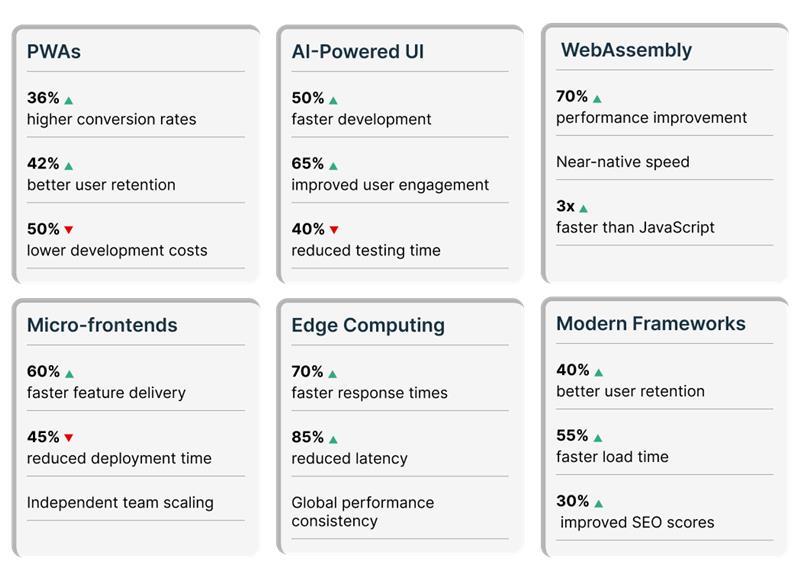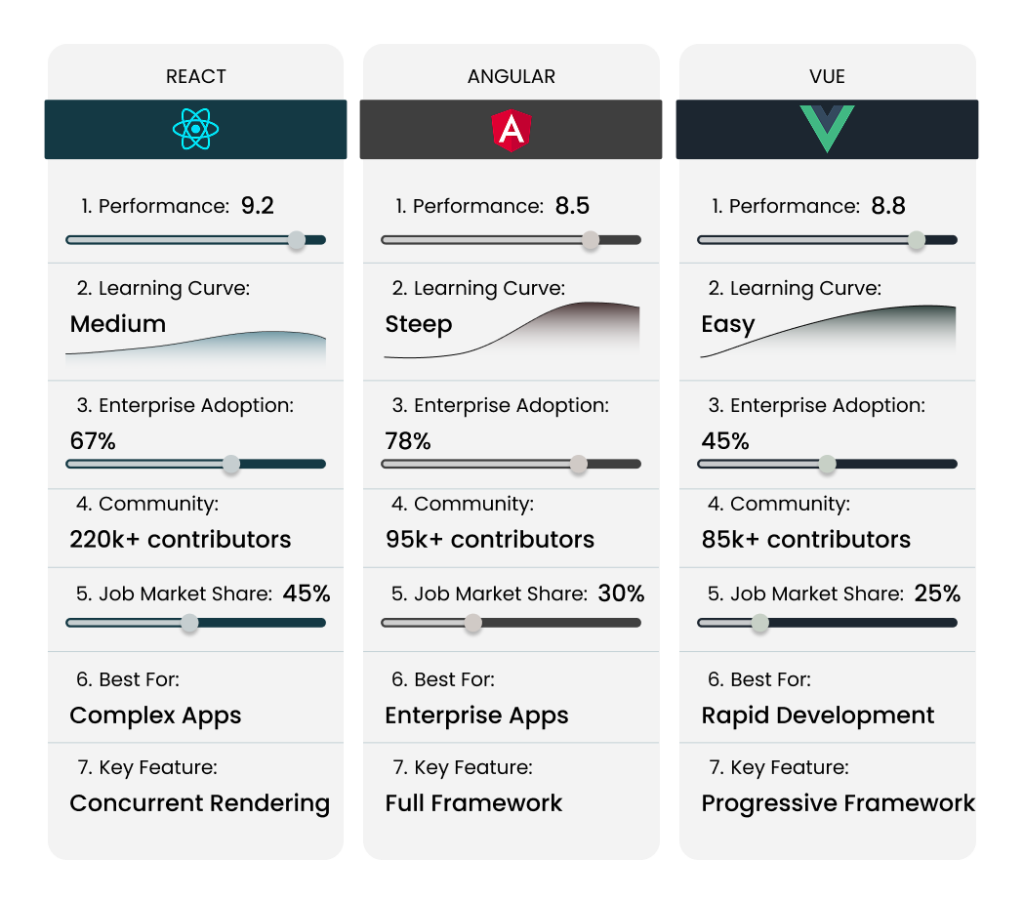Introduction
Front-end development is experiencing its most dynamic period yet, with revolutionary technologies reshaping how users interact with digital products. As we progress through 2025, businesses that adopt these front-end development trends will gain substantial advantages in user engagement, performance metrics, and market competitiveness.
Enterprise-level organizations worldwide are recognizing that modern front-end development has a direct impact on revenue generation, customer retention, and operational efficiency. The cost of falling behind these trends far exceeds the investment required to implement them, making strategic front-end development planning essential for business success.
At Onboardnow, we connect global businesses with elite front-end developers who master these emerging technologies, ensuring your digital transformation initiatives leverage the most impactful front-end development approaches available today.
Why Front-End Development Trends Matter
The relationship between cutting-edge front-end development and business outcomes has never been clearer. Companies implementing modern front-end development practices report 65% faster load times, 40% higher conversion rates, and significantly improved user satisfaction scores.

When businesses hire front-end developers who understand current trends, they invest in measurable competitive advantages. These professionals bring expertise in performance optimization, accessibility compliance, and user experience enhancement that directly translates to improved business metrics and customer loyalty.
What Are the Best Front-End Frameworks 2025?
React vs. Angular vs. Vue

The JavaScript framework landscape continues to evolve, with many companies choosing to hire React developers due to its robust ecosystem and high developer productivity. React’s concurrent features and server components make it a strong choice for building high-performance applications with complex state management needs.
Hire Angular developers in 2025 introduces enhanced standalone components and improved hydration, making it perfect for large-scale enterprise applications. Vue’s composition API and excellent TypeScript integration position it as the optimal choice for rapid development cycles and smaller teams.
For businesses evaluating these frameworks, React offers the largest talent pool and ecosystem, Angular provides enterprise-grade structure and tooling, and Vue delivers simplicity without sacrificing powerful features. Looking to build with React, Angular, or Vue? Hire dedicated developers who specialize in the framework that best fits your business needs.
Top Front-End Development Trends
AI-Powered UI and AI Web Development Tools
Artificial intelligence is fundamentally transforming front-end development through intelligent user interfaces that adapt to individual user behavior patterns. AI-powered UI components now offer real-time personalization, predictive content loading, and context-aware interactions, significantly enhancing user engagement.

Tools like Uizard and Galileo AI enable designers to skip manual CSS work entirely, allowing for rapid prototyping and automated design-to-code workflows. AI personalization in web development utilizes machine learning algorithms to tailor layouts, content, and functionality to individual user preferences and behavioral data.
These AI web development tools reduce development time by up to 50% while improving user experience quality through data-driven interface optimization.
WebAssembly in Front-End Development
WebAssembly (Wasm) is transforming web development in 2025 with the help of allowing near-native performance for computationally intensive applications directly in browsers. Frontend developers can write code in languages like C, C++, and Rust for more productive results, expanding the possibilities for web-based applications.
WebAssembly is no longer limited to game development – it’s now powering high-performance front-end applications, such as video editing tools, 3D rendering, and real-time data visualization. This technology enables complex applications, such as CAD software, image processing tools, and scientific computing platforms, to run efficiently in web browsers.
Progressive Web Apps (PWAs) Evolution
Progressive Web Apps continue revolutionizing mobile application development by combining web accessibility with native app functionality. PWAs in 2025 offer offline-first architectures, background synchronization, and push notification capabilities that rival traditional mobile applications. The business case for PWAs remains compelling: reduced development costs, broader device compatibility, and improved user engagement metrics. Companies implementing PWAs report 36% higher conversion rates and a 42% increase in user retention compared to traditional web applications. Many organizations now hire React Native developers alongside PWA implementation to build comprehensive, cross-platform solutions that maximize reach and minimize development overhead.
No-Code and Low-Code Front-End Development
The rise of no-code and low-code platforms is democratizing front-end development, enabling businesses to create sophisticated user interfaces without extensive programming expertise. The best no-code tools of 2025 include advanced visual builders, component libraries, and integration capabilities that support complex business logic.
Low-code web development trends focus on hybrid approaches where developers can extend visual development with custom code when needed. This approach accelerates time-to-market while maintaining flexibility for unique requirements.
The implementation of these technologies requires specialized expertise that’s often challenging to find in today’s competitive market. Explore how to hire a software developer with the right expertise to turn these innovations into real-world solutions.
Micro-Frontends Architecture
Micro-frontend architecture addresses the complexity challenges of large-scale front-end applications by decomposing monolithic interfaces into independent, deployable components. This approach enables teams to work autonomously while maintaining consistent user experiences across application sections.
The benefits include improved scalability, technology diversity, and faster deployment cycles. Enterprise organizations adopting micro-frontends report 60% speedier feature delivery and reduced technical debt accumulation.
Edge Computing and Real-Time Data Processing
In front-end development, edge computing integration helps minimize latency by processing data closer to users’ geographic locations. This shortens the path data takes, improving speed and efficiency. This trend particularly benefits applications requiring real-time interactions, such as collaborative platforms, gaming interfaces, and IoT dashboards.
Front-end applications leveraging edge computing deliver 70% faster response times and improved user satisfaction scores, particularly for global user bases that require consistent performance across different regions.
JavaScript Trends
Modern JavaScript continues to evolve with enhanced performance optimization, improved TypeScript integration, and improved development tooling. ES2025 (also known as ECMAScript 2025) features include pattern matching, temporal API enhancements, and advanced async/await capabilities that streamline complex asynchronous operations.
The trend toward full-stack JavaScript frameworks enables companies to build scalable applications with consistent, high-performing technology stacks. Many teams hire Next.js developers to deliver fast, SEO-friendly front-end experiences using server-side rendering and static site generation. On the backend, organizations hire Node.js developers to build real-time, event-driven architectures that scale effortlessly with business demands.
How Onboardnow Connects You With Expert Front-end Developers
At Onboardnow, we understand that implementing these front-end development trends requires specialized expertise that many organizations struggle to find internally. Our comprehensive talent integration services connect businesses with pre-vetted front-end developers who have proven experience with these emerging technologies.
Our rigorous screening process evaluates candidates’ proficiency in AI-powered UI development, WebAssembly implementation, Progressive Web App (PWA) creation, and modern JavaScript frameworks. We ensure every developer understands not just the technical implementation but also the business impact of these front-end development trends.
Whether you need individual contributors to enhance existing teams or complete front-end development squads, our staff augmentation approach provides the flexibility and expertise required to succeed in today’s competitive digital landscape.
Visit Onboardnow to explore our developer network and start building your next-generation front-end applications.
Key Takeaways for Hiring the Best Front-End Developers in 2025
The front-end development landscape presents unprecedented opportunities for businesses willing to embrace these transformative trends. From AI-powered interfaces that personalize user experiences to WebAssembly applications that deliver near-native performance, these technologies are reshaping what is possible in web development.
Success in this evolving landscape requires access to skilled front-end developers who understand both the technical implementation and business impact of these trends. The investment in modern front-end development expertise pays dividends through improved user engagement, higher conversion rates, and enhanced competitive positioning.
Transform your digital presence with cutting-edge front-end development. Partner with Onboardnow today to access expert developers who can implement these game-changing technologies for your business success.
FAQs
What are the top front-end development trends in 2025?
The most impactful front-end development trends in 2025 include AI-powered user interfaces, WebAssembly integration, evolved Progressive Web Apps, no-code and low-code development platforms, micro-frontend architecture, and edge computing implementation. These trends focus on performance optimization, user experience enhancement, and development efficiency.
React vs. Angular vs. Vue 2025: Which framework should I choose?
React remains the best choice for most projects due to its extensive ecosystem and concurrent features. Angular excels for large enterprise applications that require a robust structure and tooling. Vue combines ease of use with robust capabilities, making it ideal for fast-paced development. Your choice should depend on project scale, team expertise, and long-term maintenance requirements.
How is AI transforming front-end development in 2025?
AI is revolutionizing front-end development through automated design-to-code tools, intelligent user interface personalization, and predictive user experience optimization. AI-powered UI components adapt to user behavior in real time, while AI web development tools reduce manual coding by up to 50% and enhance application quality.
What makes WebAssembly important for front-end applications?
WebAssembly delivers high-speed performance for demanding tasks right within the browser, close to native execution speed. It allows developers to utilize languages such as C++, Rust, and Go for front-end development, opening up possibilities for complex applications like video editing, 3D rendering, and scientific computing tools that previously required native applications.
How can businesses benefit from hiring front-end developers who know these trends?
Businesses hiring front-end developers with expertise in 2025 trends experience measurable improvements: 65% faster application load times, 40% higher conversion rates, and significantly improved user satisfaction. These developers bring knowledge of performance optimization, accessibility compliance, and modern user experience practices that directly impact business outcomes.





